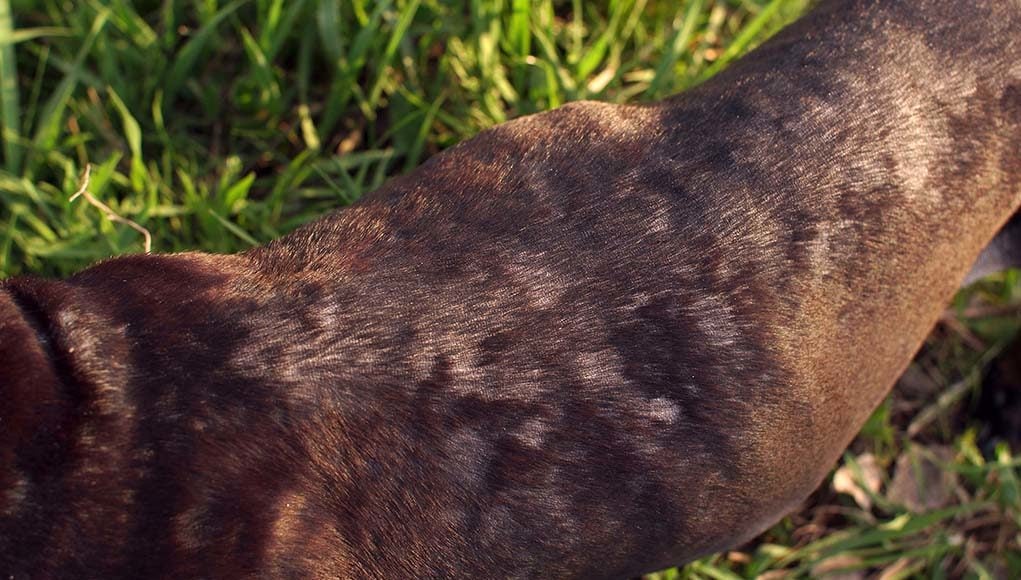A ringworm infection, or as it is medically called – dermatophytosis or tinea – is a parasitic infection that can befall your dog, as well as your cat or other pets, and even yourself.
Often mistakenly lumped together with worm infections such as tapeworms, roundworms, whipworms, hookworms, and others because of its name, ringworm in dogs isn't actually caused by worms – it's a fungal infection.
A brief on ringworm infection
This fungal infection is commonly called “ringworm” because the signature physical appearance of a ringworm infection is circular red lesions that look like rings. It was never associated with any worms (1).
Ringworm as in other pets and humans alike – is a fungal infection of the skin.
The fungus lives and grows in the upper layer of the skin and in the dog's hair follicles.
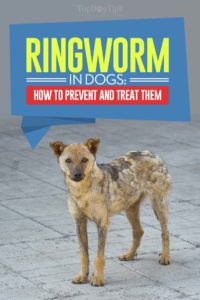
Is ringworm contagious from dogs to humans?
It is not a life-threatening disease, but it's highly contagious to other dogs and humans and requires a visit to a veterinarian.
Occasionally, ringworm can also occur in the nails.
It is a superficial infection and doesn't spread over the entire body – it usually stays contained to several areas of the dog's body.
However, in dogs with compromised immune systems (such as older dogs or puppies), it can spread quite extensively (2).
Ringworm spreads through contact, which is why it is important to keep good hygiene in the house.
Frequent vacuuming of your infected dog's hair is the key to preventing the spread of the ringworm infection to other members of the household, be it other pets, your family or yourself.
Possible ringworm infections are also why you should avoid contact with homeless and stray animals.
Many of them are infected and can in turn, infect you, or at the very least, you can carry a ringworm infection home.
The fungal spores of the ringworm infection can remain infectious for up to 18 months, so infected hairs can be dangerous for you and your pet for quite a long time (3).
ALSO READ: 6 Dog Skin Conditions and What To Do About Them
Ringworm in Dogs
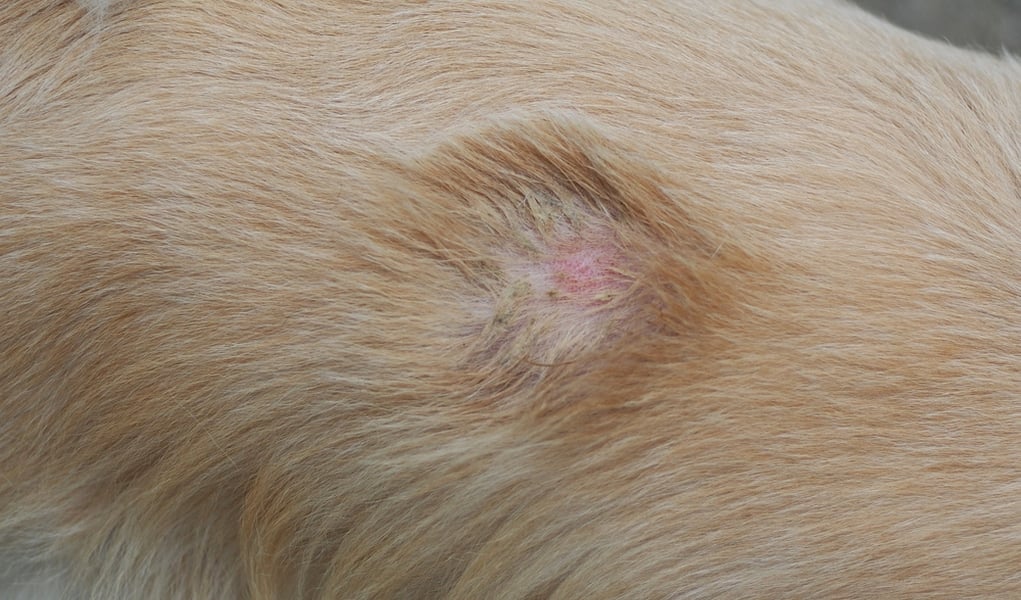
Symptoms of Ringworm in Dogs
Being a skin infection, ringworm is fairly easy to notice and identify on your pet.
This is a welcome help in battling ringworm in dogs, since it is very highly contagious and the sooner you spot it and take your dog to a veterinarian, the better for both the dog and your entire household.
Early identification and treatment of ringworm are key in preventing it from spreading over your other pets and even yourself (4).
If you notice any of the symptoms below, contact your veterinarian immediately:
- hair loss, particularly in areas with a circular shape
- distinctive patches of dry and unusually brittle hair
- unusually high amounts of dandruff or flakiness of the skin that resembles dandruff
- skin inflammations or scaly skin
- darkened skin
- excessive itchiness
- round lesions on the skin
- oozing from skin lesions
- skin inflammations at the bottom of the paws and around the claws
- an unusual brittleness to the claws, they are rougher than usual
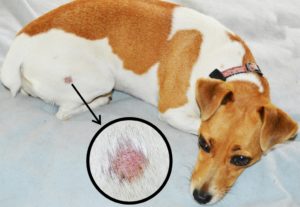
The main parts of the dog's body where these symptoms can manifest themselves include the dog's head, ears, paws, claws and forelimbs.
Also, keep in mind that your dog may not be sick, but still be a “carrier” of ringworm infection.
As a carrier, a dog doesn't exhibit any symptoms but is still just as contagious to you and other people or pets (5).
For this and many other reasons, when adopting a dog (especially a stray dog) always go to the veterinarian as soon as possible for the initial check-up, and avoid contact with strays, unless you are going to adopt them.
Who is Most Susceptible?
Ringworm infections are not breed-specific. Ringworm can infect not only every dog breed, but also cats, other pets and even people.
Statistically, ringworm is more frequently seen in dogs with troubled or weakened immune systems.
Young puppies and older dogs are extremely susceptible (6).
Dogs under one year or malnourished, stressed or sickly animals are highly susceptible to ringworm as well.
Causes of Ringworm in Dogs
Ringworm infection is typically caused by any one of three different types of fungi:
- Microsporum canis
- Microsporum gypseum
- Trichophyton mentagrophytes
Depending on your geographic location, either of these three fungi can be more popular than the rest (6).
On average, Microsporum canis is responsible for about 70% of the cases of ringworm in dogs, Microsporum gypseum is responsible for about 20% of ringworm cases in dogs and Trichophyton mentagrophytes for about 10% of the cases of ringworm in dogs.
Since ringworm appears much more frequently in dogs with weakened immune systems, environments with dense canine populations can often lead to a massive ringworm outbreak.
Shelters or kennels, especially if they offer poor nutrition for their dogs, display poor management practices or maintain poor hygiene, can cause a lot of ringworm troubles for dogs.
That is why even if you're adopting a dog from a shelter (even a high-profile shelter that you trust), you should always make sure that he receives proper vet care after you've just adopted him.
Your dog can contract ringworm spores from other infected animals as well not just other dogs.
RECOMMENDED: Top 7 Best Dog Skin Infection Treatments (OTC)
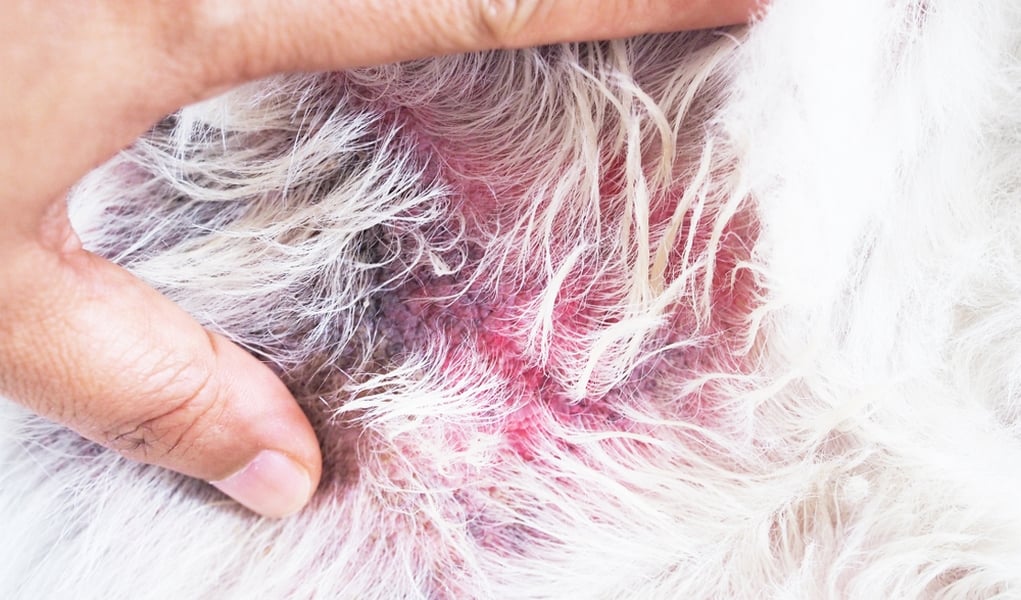
How is Ringworm in Dogs Diagnosed?
Properly diagnosing ringworm in your dog as soon as possible is extremely important both for your pet and for yourself.
Other than simply observing the typical symptoms of ringworm with the naked eye, your veterinarian will perform several different tests to ensure a proper diagnosis.
They'll use an ultraviolet light, called Wood's Lamp, to get a better look at your dog's hair and skin.
Your vet can also perform a microscopic examination of your dog's hair, perform a fungal culture from your dog's skin, or even get a skin biopsy.
All this is important not just to determine that your dog does have ringworm infection (which can often time be obvious just by its symptoms) but to diagnose the exact type and severity of the ringworm infection (7).
Different types of ringworm in dogs require different treatments.
Once the ringworm infection has been properly diagnosed, it is time for its immediate treatment.
Treatment for Ringworm in Dogs

First your vet will need to verify that its the ringworm fungus by taking a skin or hair sample.
Treating ringworm is a complicated and time-consuming operation that involves much more than simply giving your dog a few pills.
This isn't to say that ringworm in dogs is sometimes incurable.
The infection is treatable, but due to its persistence and high contagious rates, the treatment of ringworm usually means “treating” your entire home and household.
Depending on the severity of the condition, your vet may urge you to leave your dog with them so that he can spend some time in a confined space.
Even if the infection isn't that imposing, if you have other pets at home, children or adults with compromised immune systems, keeping the infected dog in quarantine is strongly recommended.
Even if none of this is the case and you take your dog back home, it is still a great idea to confine him to one room.
The dog itself can also remain contagious for 3 weeks, so you'll need to make sure that the dog's room and your home as a whole is regularly vacuumed and cleaned both for the duration of the ringworm treatment, and after it.
To further maintain your environment, it's best to confine your dog to a room with no rugs or carpets for easier vacuuming.
Ringworm in dogs spreads through the dog's hair and can last on said hair and off the dog's body for up to 18 months.
Washable furniture covers are also great to use in this situation.
Lastly, it's important to make sure that all other members of the household – people and pets alike – are as healthy as possible and have strong and capable immune systems.
As for the dog's veterinary treatment itself, your vet will prescribe whatever's best based on the exact diagnosis.
Possible dog ringworm treatments include:
- Anti-fungal medications – can be a lot of different types ranging from oral medications to a topical treatment, including even medicated shampoos with miconazole or a dip such as lime sulfur.
- Elizabethan collar/cone – placed around the dog's neck, an Elizabethan collar helps to prevent the dog from licking and ingesting any anti-fungal medications applied to his skin.
- Clipping of the fur – necessary in more severe cases and often recommended in even lighter cases
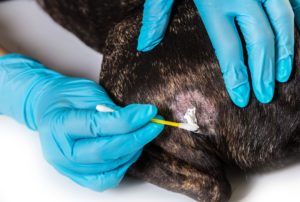
If they give you topical treatments, make sure to consistently apply it to the affected areas as often as the prescriptions state.
These treatments usually last anywhere between 1 and 3 weeks. Your dog is contagious even while he's being treated.
This means that you should still maintain a relative quarantine for up to 3 weeks.
The lesions will start healing almost immediately; however, you shouldn't take that as a sign that your dog is cured.
The ringworm infection will still remain active even after the lesions have softened and cleared.
Keep the treatment plan going for as long as your vet recommends.
Stopping the treatment prematurely is almost certain to bring the infection back.
Even if both the treatment and the quarantine are done correctly, there's still no guarantee that the infection won't reoccur.
In the meantime avoid touching the affected areas with your bare skin.
Do not despair, however, as stubborn as ringworm is, it's still treatable and is rarely life-threatening. Just keep isolating and treating your dog until the disease is completely cured.
MORE: Why Is My Dog Itching? 4 Scientific Reasons and Proven Treatments
What to Expect After Ringworm Treatment
Even after successful treatment of ringworm in dogs, the infection can still have bothersome results for quite a while.
It is not rare for animals to be clinically cured and clean but remain fungal culture positive.
In other words, your dog could still be a ringworm carrier and, therefore, be contagious to other animals and people.
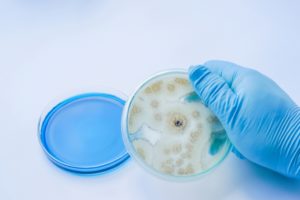
For this reason, it is strongly recommended to perform additional fungal cultures at the end of your dog's treatment.
If positive, you'll need to continue treating your pet until there are one or two negative fungal cultures.
Fungal cultures should be taken weekly or biweekly, as your vet prescribes.
For animals that are receiving griseofulvin (an anti-fungal antibiotic), complete blood counts should also be performed weekly or biweekly.
If your dog has received ketoconazole or itraconazole (other types of anti-fungal medication), blood work to monitor the liver may also be recommended.
Proper treatment and proper post-treatment are near-guaranteed to completely cure your dog and allow you to return to your regular, ringworm-free life.
How long will my dog be contagious?
As long as the infection is being treated aggressively and consistently with ointment or oral medication it will go away.
A dog should only remain contagious about three weeks, four at the most.
Prevention of Ringworm in Dogs
If your dog and other pets have never suffered from ringworm, worrying about it isn't necessary.
Ringworm in dogs doesn't just appear in the body; it needs to be carried from an outside source.
As long as your dog doesn't have contact with diseased animals, you yourself don't carry the disease home and rodents don't have access to your home environment, your family and pets should be perfectly safe from a ringworm infection.
If any of the above happens to be the case, ringworm is not the only disease you should worry about.
It is always a good idea to limit your dog's and home's exposure to stray and homeless animals, as well as to eliminate any possible rodent presence.
However, stopping your dog from playing with other pets in the park altogether is rather excessive and unnecessary in most cases.
If, on the other hand, your Fido or another pet has suffered from ringworm in the past year and a half, then preventing further ringworm outbreaks becomes a very important task.
Ringworm can survive for up to 18 months on the dog's hair or your home's furniture, carpet, drapes, etc.
Here are a few tips to help prevent ringworm in dogs:
- Perform regular fungal cultures not only to the infected (and then treated) animal, but to all animals in the household that have had contact with him.
- Keep your home environment clean. Keeping up with regular vacuuming, washing of the furniture, bathing your dog and other pets, etc., for months after the ringworm infection is vital. This includes any and all grooming tools.
- Disinfect your home. As far as the cleaning of your house goes, ASPCA experts recommend a mix of 1 part bleach and 10 parts water as the best possible disinfectant.
- Keep yourself clean. Especially during treatment and in the first months after it, additional accent on your own personal hygiene is also strongly recommended. Always wash up after contact with your dog and his confined room, take regular baths, and pay special attention to your personal hygiene.
FAQs
How can I treat ringworm on my dog at home?
If you catch it early and diagnose it, you can treat it with a couple baths with antifungal shampoos or dips.
Typically, you'll want to bathe your dog with the shampoo at least two times per week.
Closing Thoughts
Ringworm, fortunately, is not a life threatening condition but is very contagious. It's a fungus that thousands of dog owners deal with annually.
Take it seriously and do everything you can to prevent it from spreading to other pets or even yourself!
Why You Should Trust Top Dog Tips
Well, as dog owners, we also want to know as much as we possibly can and find “the truth” out there in dog ownership.
We want to clear the fog that surrounds certain topics like nutrition, dog care, dog health, and more.
So we went ahead and brought aboard not only long-time dog owners but Veterinarians onto our website.
For each article we publish, we want to make sure the information is accurate and has been vetted by real veterinarians.
READ NEXT: 5 Ways To Help Dogs with Itchy Skin


